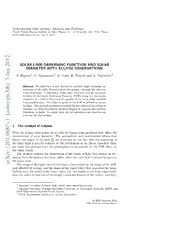
Solar limb darkening function and solar diameter with eclipses observations PDF
Preview Solar limb darkening function and solar diameter with eclipses observations
Understanding Solar Activity: Advances and Challenges Fourth French-Chinese meeting on Solar Physics 15 - 18 November, 2011 Nice, France EAS Publications Series, Vol. ?, 2012 2 1 0 2 SOLAR LIMB DARKENING FUNCTION AND SOLAR DIAMETER WITH ECLIPSE OBSERVATIONS n a J A. Raponi1, C. Sigismondi2, K. Guhl, R. Nugent and A. Tegtmeier3 3 ] R Abstract. We introduce a new method to perform high resolution as- S trometry of the solar diameter from the ground, through the observa- . tions of eclipses. A discussion of the solar diameter and its variations h is linked to the Limb Darkening Function (LDF) using the luminosity p evolution of a Baily’s Bead and the profile of the lunar limb available - o fromsatellitedata. TheinflexionpointoftheLDFisdefinedastheso- r larlimb. Themethodproposedisappliedforthevideosoftheeclipsein t s January,15,2010recordedbyRichardNugentinUgandaandAndreas a TegtmeierinIndia. Anupperlimit fortheinflexionpointposition has [ been set for that eclipse. 1 v 5 1 The method of eclipses 8 6 With the eclipse observation we are able to bypass some problems that affect the 0 measurement of solar diameter. The atmospheric and instrumental effects that . 1 distort the shape of the limb [1] are overcome by the fact that the scattering of 0 the Sun’s light is greatly reduced by the occultation of the Moon, therefore there 2 1 are much less photons from the photosphere to be poured, by the PSF effect, in : the outer region. v The method exploits the observation of the beads of light that appear or dis- i X appearfromthe bottomofalunarvalley whenthe solarlimbis almosttangentto r the lunar limb. a TheshapeofthelightcurveofthebeadisdeterminedbytheshapeoftheLDF (notaffectedby seeing)andthe shape ofthe lunarvalley thatgeneratesthe bead. Calling w(x) the width ofthe lunar valley (i.e. the length of the solaredge visible fromthevalleyinfunctionoftheheightxfromthebottomofthevalley),andB(x) 1 SapienzaUniversityofRome,Italy. email: [email protected] 2 Sapienza University of Rome and ICRA, University of Nice-Sophia Antipolis, IRSOL and GPA-ObservatorioNacionalRiodeJaneiro. 3 IOTA,International OccultationTimingAssociation (cid:13)c EDPSciences 2012 DOI:(willbeinsertedlater) 2 Understanding Solar Activity: Advances and Challenges Fig. 1. Everystep in thegeometry of thesolar-lunar layers(up) corresponds toa given instantinthelightcurve(down). Thevalueofthelightcurveisthecontributeofallthe layers. the surface brightness profile (i.e. the LDF), one could see the light curve L(y) as a convolutionof B(x)and w(x), being |y | the distance betweenthe botton ofthe lunar valley and the standardsolaredge, setting to 0 the position of the standard edge. L(y)=R B(x)w(y−x)dx The discrete convolution is: L(m)=PB(n)w(m−n)h where n, m are the index of the discrete layers corresponding to x, y coordinate and h the layers thickness. The profile of the LDF is discretized in order to calculate the deconvolution and thus to obtain the solar layers B(n) (see Fig. 1). 2 An application of the method We studied the videos of the annular eclipse in January 15, 2010 realized by RichardNugentinUgandaandAndreasTegtmeierinIndiawithCCDcameraWa- tecandMatsukovtelescope. TwobeadslocatedatAxisAngle1 (AA)=171◦,177◦ are analyzed for both the videos. The lunar valley analysis is performed with the 2 Occult 4 software that exploits the new lunar profile obtained by the laser al- timeter (LALT)onboardthe JapaneselunarexplorerKaguya3. Thechoiceofthe thickness of the layers has to be optimal: large enough to reduce Bn uncertain- ties, but small enough to have a goodresolutionof the LDF. The resulting points showtheprofilesobtainedintwodifferentpositions. Theinflectionpointisclearly between the two profiles (see Fig. 2). 1theanglearoundthelimboftheMoon,measuredEastwardfromtheMoon’sNorthpole 2www.lunar−occultations.com/iota/occult4.htm 3http://wms.selene.jaxa.jp/seleneviewer/index e.html Limb Darkening Function with Eclipse Observations 3 Fig. 2.TheluminosityprofilesobtainedforthebeadatAA=177◦ areplottedandput together. Theinnerand brighterpart isobtained from Tegtmeier’s video; theouterand weakerpartisobtainedfromNugent’svideo. Theluminosityprofileisnormalizedtothe centerofthesolardiskaccordingtoRogerson[2]fortheinnerpart,andinarbitraryway for the outer part. The zero of the abscissa is the position of the standard solar limb with a radiusof 959.63 arcsec at 1 AU.The error bars on y axis are the90% confidence level. Theerrorbarson x axisarethethickness(h)of thelunarlayers. Thesolid lineis aninterpolation between theprofilesandgivesapossible scenarioon theposition ofthe inflection point. 3 Conclusions This study takes into account the potentiality of the observation of eclipses in defining the luminosity profile of the edge of the Sun. The method proposed considers the bead as a light curve forged by the LDF andthe profile of the lunar valley. A firstapplicationontwo beads of the annular eclipseon15January2010,isdescribedinthisstudy. Weobtainadetailedprofile, demonstrating the functionality of the method. Although it was impossible to observe the inflection point, its position is defined within a narrow range. The solar radius is thus defined within this range (from -0.19 to +0.05 with respect to the standard radius), resulting compatible with the standard value. References Djafer, D., Thuillier, G., Sofia, S., A Comparison among Solar Diameter Measurements Carried Out from the Ground and outside Earths Atmosphere., Astrophys.J. 676 p. 651 657 (2008). Rogerson, J.B. The Solar Limb Intensity Profile., Astrophys. J. 130 p. 985 (1959).
